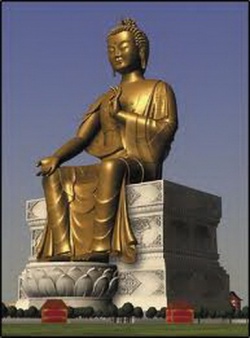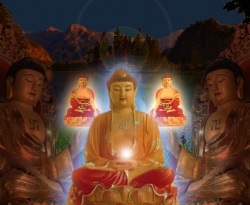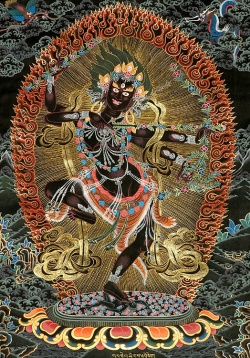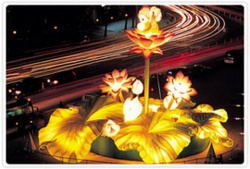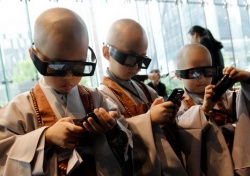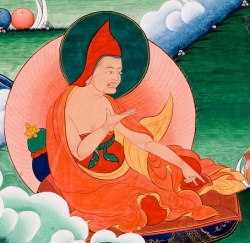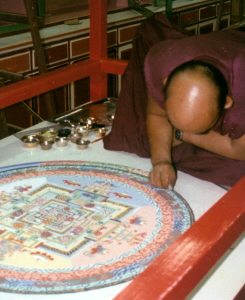Difference between revisions of "Throne holder"
| (3 intermediate revisions by the same user not shown) | |||
| Line 8: | Line 8: | ||
| − | + | ||
All [[monasteries]] have "[[throne-holders]]," the most revered [[lamas]] of their [[monasteries]] | All [[monasteries]] have "[[throne-holders]]," the most revered [[lamas]] of their [[monasteries]] | ||
| − | The symposium held this {{Wiki|past}} weekend at the | + | The symposium held this {{Wiki|past}} weekend at the [[University of Wiki|San Francisco]] was a [[gathering]] of [[scholars]] from around the [[world]] who presented papers focused on the “[[Tulku]]” ({{BigTibetan|[[སྤྲུལ་སྐུ་]]}} , [[sprul sku]]) institution of [[Tibetan Buddhism]]. |
| − | the conference was the second recent meeting focused on the [[reincarnation | + | Organized by [[professor]] [[Tsering Wangchuk]] and [[Jake Nagasawa]], |
| + | |||
| + | the conference was the second recent meeting focused on the [[reincarnation system of Tibetan Buddhism]]. | ||
There were four main panels at the conference, allowing for thirteen seasoned [[scholars]] to {{Wiki|present}} their research: | There were four main panels at the conference, allowing for thirteen seasoned [[scholars]] to {{Wiki|present}} their research: | ||
| Line 26: | Line 28: | ||
| − | Representatives {{Wiki|speaking}} at the conference ran the gamut of [[scholars]] and although some papers seemed farther from the theme than others, the threads tying them together were questions about the history, place and function of the unique system of dynasties of [[reincarnated]] [[Buddhist masters]] solidified in [[Tibetan culture]] as the “[[Tulku System]].” | + | Representatives {{Wiki|speaking}} at the conference ran the gamut of [[scholars]] and although some papers seemed farther from the theme than others, the threads tying them together were questions about the history, |
| + | |||
| + | place and function of the unique system of dynasties of [[reincarnated]] [[Buddhist masters]] solidified in [[Tibetan culture]] as the “[[Tulku System]].” | ||
I’m not sure what general readers [[imagine]] [[Tibetan history]] may have been like, but perhaps [[Wikipedia:Imagination|imagining]] a [[Tibetan]] version of Game of Thrones with the houses as [[monastic]] {{Wiki|institutions}} continuing not through a lord’s {{Wiki|blood}} relations but via {{Wiki|recognition}} and enthronement of child prodigies destined to take the place of previous [[throne holders]] is a useful “[[imaginary]].” | I’m not sure what general readers [[imagine]] [[Tibetan history]] may have been like, but perhaps [[Wikipedia:Imagination|imagining]] a [[Tibetan]] version of Game of Thrones with the houses as [[monastic]] {{Wiki|institutions}} continuing not through a lord’s {{Wiki|blood}} relations but via {{Wiki|recognition}} and enthronement of child prodigies destined to take the place of previous [[throne holders]] is a useful “[[imaginary]].” | ||
| Line 32: | Line 36: | ||
The [[reasons]] for a [[gathering]] focused on discussing the [[Tulku Institution]] are many: it is an [[essential]] and unique part of [[Tibetan culture]] and history, it is a useful entry point for discussions about the [[transmission]] of [[Buddhism]] or | The [[reasons]] for a [[gathering]] focused on discussing the [[Tulku Institution]] are many: it is an [[essential]] and unique part of [[Tibetan culture]] and history, it is a useful entry point for discussions about the [[transmission]] of [[Buddhism]] or | ||
| − | about the [[philosophical]] and [[religious]] [[beliefs]] of historical [[Tibetan]] peoples and of | + | about the [[philosophical]] and [[religious]] [[beliefs]] of historical [[Tibetan]] peoples and of [[modern Buddhist practitioners]], and it is a controversial topic, both inside and outside of the [[tradition]]. |
In recent years we have seen young [[tulkus]] rebelling against their [[traditions]] and revealing improprieties, movie {{Wiki|stars}} becoming [[tulkus]], and reports of general [[distrust]] of the [[tulku system]] in {{Wiki|modern}} [[Tibetan]] peoples. | In recent years we have seen young [[tulkus]] rebelling against their [[traditions]] and revealing improprieties, movie {{Wiki|stars}} becoming [[tulkus]], and reports of general [[distrust]] of the [[tulku system]] in {{Wiki|modern}} [[Tibetan]] peoples. | ||
| Line 47: | Line 51: | ||
Some presenters discussed the idealized [[tulku]] as a prodigy motivated by the will to help all [[sentient beings]], while others focused on children forced into servitude of an institution motivated by [[greed]] and power. | Some presenters discussed the idealized [[tulku]] as a prodigy motivated by the will to help all [[sentient beings]], while others focused on children forced into servitude of an institution motivated by [[greed]] and power. | ||
| − | Some discussed the history of the [[tulku institution]] or the particulars of the [[development]] of [[tulku lineages]] in particular [[monastic]] | + | Some discussed the history of the [[tulku institution]] or the particulars of the [[development]] of [[tulku lineages]] in particular [[monastic institutions]], and others focused on various responses to the question of its continuation in the {{Wiki|modern}} [[world]]. |
Dr. Lopez’s presentation was expertly delivered and fascinating in that it revealed that a 20th century [[gathering]] of the most powerful exiled [[Tibetan]] leaders ended with a moratorium on the {{Wiki|recognition}} of [[tulkus]], which lasted a decade before some unnamed group broke it, ushering in open season on [[tulku]] {{Wiki|recognition}}. | Dr. Lopez’s presentation was expertly delivered and fascinating in that it revealed that a 20th century [[gathering]] of the most powerful exiled [[Tibetan]] leaders ended with a moratorium on the {{Wiki|recognition}} of [[tulkus]], which lasted a decade before some unnamed group broke it, ushering in open season on [[tulku]] {{Wiki|recognition}}. | ||
| Line 55: | Line 59: | ||
However, it appears no one has studied the meeting in depth and we don’t know whether this was motivated by an attempt to end the [[tulku]] system for good because of corruption, or if it was an issue of expediency brought on by exile, or some other [[reason]]. | However, it appears no one has studied the meeting in depth and we don’t know whether this was motivated by an attempt to end the [[tulku]] system for good because of corruption, or if it was an issue of expediency brought on by exile, or some other [[reason]]. | ||
| − | Lopez weaved together reports from the earliest [[Western]] accounts of encounters with young [[tulkus]] (they must be {{Wiki|demons}}!), {{Wiki|Central Asian}} and {{Wiki|European}} history, and {{Wiki|modern}} accounts. | + | [[Lopez]] weaved together reports from the earliest [[Western]] accounts of encounters with young [[tulkus]] (they must be {{Wiki|demons}}!), {{Wiki|Central Asian}} and {{Wiki|European}} history, and {{Wiki|modern}} accounts. |
| − | His talk was called, “Four Possibilities,” referring to a [[logical]] relationship between the term “[[lama]]” and “[[tulku]],” argued by the [[Dalai Lama]] in a talk attended by Dr. Lopez to be “[[mushi]]“. | + | His talk was called, “Four Possibilities,” referring to a [[logical]] relationship between the term “[[lama]]” and “[[tulku]],” argued by the [[Dalai Lama]] in a talk attended by Dr. [[Lopez]] to be “[[mushi]]“. |
| − | |||
| − | |||
| + | Namely, there are [[people]] who are neither [[lamas]] nor [[tulkus]], | ||
| + | [[people]] who are both [[lamas]] and [[tulkus]], | ||
| + | |||
| + | [[people]] who are [[lamas]] but are not [[tulkus]], and | ||
| + | |||
| + | [[people]] who are [[tulkus]] who are not [[lamas]]. | ||
| + | |||
| + | |||
| + | |||
| + | It is this last one that gives [[people]] pause, as it is generally assumed that [[tulkus]] are not merely [[lamas]], but are the representatives of the [[highest level of realized masters]]. | ||
While Lopez’s approach was historical and text-based, on day two Dr. Hopkins gave his usual hilarious, rambling, and intensely personal account of study with [[Tibetan masters]] such as the [[Dalai Lama]]. | While Lopez’s approach was historical and text-based, on day two Dr. Hopkins gave his usual hilarious, rambling, and intensely personal account of study with [[Tibetan masters]] such as the [[Dalai Lama]]. | ||
| Line 80: | Line 92: | ||
| − | The Beginning of the | + | ===The [[Beginning of the Tulku Institution]]?=== |
| Line 86: | Line 98: | ||
Sometimes [[people]] like to spice things up a bit by [[debating]] when some historical institution, [[philosophical]] school, or [[religious]] practice started or ended. | Sometimes [[people]] like to spice things up a bit by [[debating]] when some historical institution, [[philosophical]] school, or [[religious]] practice started or ended. | ||
| − | In the case of the [[Tulku institution]], the topic of this short symposium, some speakers talked about the earliest texts describing concatenated [[reincarnates]] (an unbroken line of | + | In the case of the [[Tulku institution]], the topic of this short symposium, some speakers talked about the earliest texts describing concatenated [[reincarnates]] (an [[unbroken line of dharma teachers]]) or the earliest reported {{Wiki|recognition}} of [[Tibetan people]] as [[emanations of deities]]. |
But the statement found in a text that so and so is the [[emanation]] of so and so is not the same as the {{Wiki|cultural}} [[phenomenon]] of the {{Wiki|recognition}} of a [[person]] as an [[emanation]] who then comes to take the power and [[wealth]] of the deceased leader, subsequently taking on the [[wealth]] and followers of that leader. | But the statement found in a text that so and so is the [[emanation]] of so and so is not the same as the {{Wiki|cultural}} [[phenomenon]] of the {{Wiki|recognition}} of a [[person]] as an [[emanation]] who then comes to take the power and [[wealth]] of the deceased leader, subsequently taking on the [[wealth]] and followers of that leader. | ||
| Line 92: | Line 104: | ||
Perhaps an [[interesting]] question would be, who was the first [[Tibetan]] [[student]] who, upon the [[death]] of his [[teacher]], having spent a [[lifetime]] studying with him as the executive of a [[monastery]], found himself [[bowing]] down to a child believed to be the [[reincarnation]] of his [[teacher]]? | Perhaps an [[interesting]] question would be, who was the first [[Tibetan]] [[student]] who, upon the [[death]] of his [[teacher]], having spent a [[lifetime]] studying with him as the executive of a [[monastery]], found himself [[bowing]] down to a child believed to be the [[reincarnation]] of his [[teacher]]? | ||
| − | That is, when and how did the {{Wiki|social}} event of the installment of a [[Tulku]] first occur? How meaningful was it for that [[society]]? After the conference I am still wondering about the answers to these questions. | + | That is, when and how did the {{Wiki|social}} event of the installment of a [[Tulku]] first occur? |
| + | |||
| + | How meaningful was it for that [[society]]? | ||
| + | |||
| + | After the conference I am still wondering about the answers to these questions. | ||
Some students of [[Tibetan Buddhism]] may believe that the earliest members of a [[lineage of reincarnated teachers]] held the same kind of {{Wiki|status}} as the later members of the [[lineage]]. | Some students of [[Tibetan Buddhism]] may believe that the earliest members of a [[lineage of reincarnated teachers]] held the same kind of {{Wiki|status}} as the later members of the [[lineage]]. | ||
| − | In fact, many [[lineages]] would be applied or [[recognized]] later in history, once the institution of the [[lineage]] | + | In fact, many [[lineages]] would be applied or [[recognized]] later in history, once the institution of the [[lineage holder]] became relevant. |
For instance, while surely the first [[Karmapa’s]] students revered him in his time, they may not have [[thought]] of him as a special [[reincarnation]] while he was alive. | For instance, while surely the first [[Karmapa’s]] students revered him in his time, they may not have [[thought]] of him as a special [[reincarnation]] while he was alive. | ||
| − | It was not until later [[Karmapas]] that the [[lineage]] was written down and traced backwards. So one of the questions is, when did this way of [[thinking]] about [[teachers]] come about? | + | It was not until later [[Karmapas]] that the [[lineage]] was written down and traced backwards. |
| + | |||
| + | So one of the questions is, when did this way of [[thinking]] about [[teachers]] come about? | ||
| Line 107: | Line 125: | ||
[[Guru Chowang]] appears to have inserted himself in [[Nyangral’s lineage]] line and [[Nyangral]] himself used various strategies to claim a [[lineage]] stretching back to the great [[Tibetan King]] [[Tri Song Detsen]]. | [[Guru Chowang]] appears to have inserted himself in [[Nyangral’s lineage]] line and [[Nyangral]] himself used various strategies to claim a [[lineage]] stretching back to the great [[Tibetan King]] [[Tri Song Detsen]]. | ||
| − | These are stories of [[people]] convincing themselves and others of holding the connection of an | + | These are stories of [[people]] convincing themselves and others of holding the [[connection]] of an [[unbroken lineage]] and claiming to be “[[tulku]]” – [[emanations]], not merely of a [[Buddha]] or [[deity]] in general, but of specific historical [[people]]. |
Although the basic [[logic]] is much older, it doesn’t seem to be until the 12th century that we are [[seeing]] the [[tulku]] [[logic]] instantiated in texts listing specific historical names, as indicated in [[José Cabezón’s]] paper at the conference. | Although the basic [[logic]] is much older, it doesn’t seem to be until the 12th century that we are [[seeing]] the [[tulku]] [[logic]] instantiated in texts listing specific historical names, as indicated in [[José Cabezón’s]] paper at the conference. | ||
| Line 113: | Line 131: | ||
| − | Although it is often said that the [[life]] of the [[second Karmapa]], squarely in the 13th century (1204/06-1283), marks the start of the [[Tulku institution]] | + | Although it is often said that the [[life]] of the [[second Karmapa]], squarely in the 13th century (1204/06-1283), marks the start of the [[Tulku institution]], |
| − | such as the [[third Karmapa]], [[Rangjung Dorjé]]. [[Leonard van der Kuijp]] has shown {{Wiki|evidence}} that there were [[people]] [[recognized]] as [[reincarnations]] of earlier figures in the 1100s. | + | [[José Cabezón]] mused that the textual {{Wiki|evidence}} is in fact representative of reports of what the [[second Karmapa]] said about his previous [[lives]] and could have been the work of a later writer, such as the [[third Karmapa]], [[Rangjung Dorjé]]. |
| + | |||
| + | [[Leonard van der Kuijp]] has shown {{Wiki|evidence}} that there were [[people]] [[recognized]] as [[reincarnations]] of earlier figures in the 1100s. | ||
But here we are not talking about a fully formed [[Tulku]] institution. | But here we are not talking about a fully formed [[Tulku]] institution. | ||
| − | There were, of course, earlier written accounts of [[people]] being [[recognized]] as [[emanations | + | There were, of course, earlier written accounts of [[people]] being [[recognized]] as [[emanations of deities]] and [[Buddhas]] and so forth, but what of the earliest accounts of the [[Tulku institution]] being {{Wiki|present}} and functioning in a [[Tibetan]] [[society]]? |
| − | The Fourth? Another [[lineage]]? Who was first called “[[tulku]]” by [[Tibetan]] peoples? | + | Would this be the [[third Karmapa]]? |
| + | |||
| + | The Fourth? | ||
| + | |||
| + | Another [[lineage]]? | ||
| + | |||
| + | Who was first called “[[tulku]]” by [[Tibetan]] peoples? | ||
| Line 129: | Line 155: | ||
[[Elijah Ary]], a [[recognized]] [[tulku]], a [[Canadian]], and a [[scholar]] trained at {{Wiki|Harvard}}, spoke of the small group of “[[Western Tulkus]],” many [[recognized]] by [[traditional]] [[Tibetan]] leaders but rarely [[teaching]] to {{Wiki|ethnic}} [[Tibetan]] peoples. | [[Elijah Ary]], a [[recognized]] [[tulku]], a [[Canadian]], and a [[scholar]] trained at {{Wiki|Harvard}}, spoke of the small group of “[[Western Tulkus]],” many [[recognized]] by [[traditional]] [[Tibetan]] leaders but rarely [[teaching]] to {{Wiki|ethnic}} [[Tibetan]] peoples. | ||
| − | [[Dr. Ary]] questioned the use of the term “[[Western | + | [[Dr. Ary]] questioned the use of the term “[[Western tulku]]” and talked about the unique challenges of young [[people]] [[recognized]] and expected to fulfill their [[duty]] in a [[traditional]] [[religious]] {{Wiki|culture}}. |
The clash of cultures represented by the term seems to me to be a fascinating starting place for discussions about the [[transmission]] of [[Tibetan Buddhism]] to the {{Wiki|modern}} [[Western world]]. | The clash of cultures represented by the term seems to me to be a fascinating starting place for discussions about the [[transmission]] of [[Tibetan Buddhism]] to the {{Wiki|modern}} [[Western world]]. | ||
| − | Will any [[Western | + | Will any [[Western teacher]] ever create a [[lineage of tulkus]]? |
| + | |||
| + | Would any want to? | ||
| + | |||
| + | I’m sure we can look forward to [[seeing]] more [[discussion]] of this kind in the {{Wiki|future}} as [[Tibetan Buddhism]] gains more and more {{Wiki|adherents}} in the [[West]]. | ||
see also: [[Tridzin]] | see also: [[Tridzin]] | ||
| − | + | ||
{{R}} | {{R}} | ||
http://wordpress.tsadra.org/?p=1608 | http://wordpress.tsadra.org/?p=1608 | ||
[[Category:Tulkus]] | [[Category:Tulkus]] | ||
Latest revision as of 13:37, 30 March 2016
All monasteries have "throne-holders," the most revered lamas of their monasteries
The symposium held this past weekend at the San Francisco was a gathering of scholars from around the world who presented papers focused on the “Tulku” (སྤྲུལ་སྐུ་ , sprul sku) institution of Tibetan Buddhism.
Organized by professor Tsering Wangchuk and Jake Nagasawa,
the conference was the second recent meeting focused on the reincarnation system of Tibetan Buddhism.
There were four main panels at the conference, allowing for thirteen seasoned scholars to present their research:
1) Tulkus in Transnational Buddhism: Authentication and Contestation of Hybridity in the Cross-Cultural Reincarnation System 2) Tulkus in Historical Context: Power, Knowledge, and Politics in the Innovation of the Reincarnation Institution 3) Tulkus as a Model of Ideal Beings: Embodying the Enlightened Characteristics 4) Envisioning and Retelling Birth-Stories: Tulku Lineage Narratives and the Quest for Legitimation.
Representatives speaking at the conference ran the gamut of scholars and although some papers seemed farther from the theme than others, the threads tying them together were questions about the history,
place and function of the unique system of dynasties of reincarnated Buddhist masters solidified in Tibetan culture as the “Tulku System.”
I’m not sure what general readers imagine Tibetan history may have been like, but perhaps imagining a Tibetan version of Game of Thrones with the houses as monastic institutions continuing not through a lord’s blood relations but via recognition and enthronement of child prodigies destined to take the place of previous throne holders is a useful “imaginary.”
The reasons for a gathering focused on discussing the Tulku Institution are many: it is an essential and unique part of Tibetan culture and history, it is a useful entry point for discussions about the transmission of Buddhism or
about the philosophical and religious beliefs of historical Tibetan peoples and of modern Buddhist practitioners, and it is a controversial topic, both inside and outside of the tradition.
In recent years we have seen young tulkus rebelling against their traditions and revealing improprieties, movie stars becoming tulkus, and reports of general distrust of the tulku system in modern Tibetan peoples.
Despite any of this, tulkus are often some of the most powerful and popular Tibetan Buddhist teachers.
But these controversies were less the focus of the conference as it was about presenting research on various historical figures and creating a more nuanced and detailed thick description of the phenomenon of Tulkus in Tibetan society.
Fascinating, but utterly different keynote speeches were delivered at the symposium by professors Donald Lopez and Jeffrey Hopkins.
The difference in their presentations is of course partly due to personal style, but the tension between the two approaches is illustrative of some of the tensions observable throughout the symposium.
Some presenters discussed the idealized tulku as a prodigy motivated by the will to help all sentient beings, while others focused on children forced into servitude of an institution motivated by greed and power.
Some discussed the history of the tulku institution or the particulars of the development of tulku lineages in particular monastic institutions, and others focused on various responses to the question of its continuation in the modern world.
Dr. Lopez’s presentation was expertly delivered and fascinating in that it revealed that a 20th century gathering of the most powerful exiled Tibetan leaders ended with a moratorium on the recognition of tulkus, which lasted a decade before some unnamed group broke it, ushering in open season on tulku recognition.
This is interesting because it appears that the Tibetan leaders, many of whom are recognized tulkus, found reason to suspend their own system.
However, it appears no one has studied the meeting in depth and we don’t know whether this was motivated by an attempt to end the tulku system for good because of corruption, or if it was an issue of expediency brought on by exile, or some other reason.
Lopez weaved together reports from the earliest Western accounts of encounters with young tulkus (they must be demons!), Central Asian and European history, and modern accounts.
His talk was called, “Four Possibilities,” referring to a logical relationship between the term “lama” and “tulku,” argued by the Dalai Lama in a talk attended by Dr. Lopez to be “mushi“.
Namely, there are people who are neither lamas nor tulkus,
people who are both lamas and tulkus,
people who are lamas but are not tulkus, and
people who are tulkus who are not lamas.
It is this last one that gives people pause, as it is generally assumed that tulkus are not merely lamas, but are the representatives of the highest level of realized masters.
While Lopez’s approach was historical and text-based, on day two Dr. Hopkins gave his usual hilarious, rambling, and intensely personal account of study with Tibetan masters such as the Dalai Lama.
He mixed his narrative with great jokes as well as with translations from specific philosophical texts providing traditional definitions of Tibetan Buddhist concepts such as the various kayas and the meaning of “tulku.”
This is perhaps not the place to mention the significance of some of his other comments about reincarnation, and as Hopkins himself said during his speech, perhaps there are things that should remain private.
Hopkins first emphasized the technical definitions, taken from the Gomang Curriculum material he is currently translating, that require tulkus to be dharmakayas and not merely bodhisattvas of some high level.
However, he also placed emphasis on his own doubt about most tulkus’ knowledge and he insisted that what a teacher says, and the knowledge he or she thereby displays, is more important than any official stamp of recognition as a tulku.
That he felt it necessary to admonish the audience, as though they were making the mistake of believing all tulkus to be genuinely capable teachers, is interesting in and of itself.
The Beginning of the Tulku Institution?
Sometimes people like to spice things up a bit by debating when some historical institution, philosophical school, or religious practice started or ended.
In the case of the Tulku institution, the topic of this short symposium, some speakers talked about the earliest texts describing concatenated reincarnates (an unbroken line of dharma teachers) or the earliest reported recognition of Tibetan people as emanations of deities.
But the statement found in a text that so and so is the emanation of so and so is not the same as the cultural phenomenon of the recognition of a person as an emanation who then comes to take the power and wealth of the deceased leader, subsequently taking on the wealth and followers of that leader.
Perhaps an interesting question would be, who was the first Tibetan student who, upon the death of his teacher, having spent a lifetime studying with him as the executive of a monastery, found himself bowing down to a child believed to be the reincarnation of his teacher?
That is, when and how did the social event of the installment of a Tulku first occur?
How meaningful was it for that society?
After the conference I am still wondering about the answers to these questions.
Some students of Tibetan Buddhism may believe that the earliest members of a lineage of reincarnated teachers held the same kind of status as the later members of the lineage.
In fact, many lineages would be applied or recognized later in history, once the institution of the lineage holder became relevant.
For instance, while surely the first Karmapa’s students revered him in his time, they may not have thought of him as a special reincarnation while he was alive.
It was not until later Karmapas that the lineage was written down and traced backwards.
So one of the questions is, when did this way of thinking about teachers come about?
Daniel Hirshberg’s paper at the conference, “A Post-Incarnate Usurper? Guru Chöwang’s Claim to the Patrilineal Inheritance of Nyang” indicates that a 13th century figure may have worked rather hard to become recognized as a reincarnation.
Guru Chowang appears to have inserted himself in Nyangral’s lineage line and Nyangral himself used various strategies to claim a lineage stretching back to the great Tibetan King Tri Song Detsen.
These are stories of people convincing themselves and others of holding the connection of an unbroken lineage and claiming to be “tulku” – emanations, not merely of a Buddha or deity in general, but of specific historical people.
Although the basic logic is much older, it doesn’t seem to be until the 12th century that we are seeing the tulku logic instantiated in texts listing specific historical names, as indicated in José Cabezón’s paper at the conference.
Although it is often said that the life of the second Karmapa, squarely in the 13th century (1204/06-1283), marks the start of the Tulku institution,
José Cabezón mused that the textual evidence is in fact representative of reports of what the second Karmapa said about his previous lives and could have been the work of a later writer, such as the third Karmapa, Rangjung Dorjé.
Leonard van der Kuijp has shown evidence that there were people recognized as reincarnations of earlier figures in the 1100s.
But here we are not talking about a fully formed Tulku institution.
There were, of course, earlier written accounts of people being recognized as emanations of deities and Buddhas and so forth, but what of the earliest accounts of the Tulku institution being present and functioning in a Tibetan society?
Would this be the third Karmapa?
The Fourth?
Another lineage?
Who was first called “tulku” by Tibetan peoples?
While most scholars at the conference presented information about historical figures, a few scholars focused on current living tulkus, both Western and Asian.
Elijah Ary, a recognized tulku, a Canadian, and a scholar trained at Harvard, spoke of the small group of “Western Tulkus,” many recognized by traditional Tibetan leaders but rarely teaching to ethnic Tibetan peoples.
Dr. Ary questioned the use of the term “Western tulku” and talked about the unique challenges of young people recognized and expected to fulfill their duty in a traditional religious culture.
The clash of cultures represented by the term seems to me to be a fascinating starting place for discussions about the transmission of Tibetan Buddhism to the modern Western world.
Will any Western teacher ever create a lineage of tulkus?
Would any want to?
I’m sure we can look forward to seeing more discussion of this kind in the future as Tibetan Buddhism gains more and more adherents in the West.
see also: Tridzin

